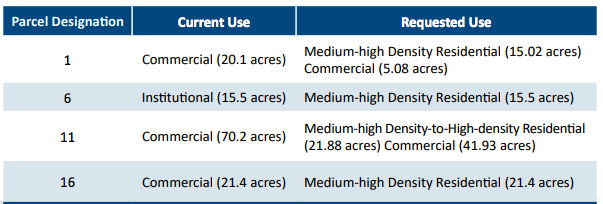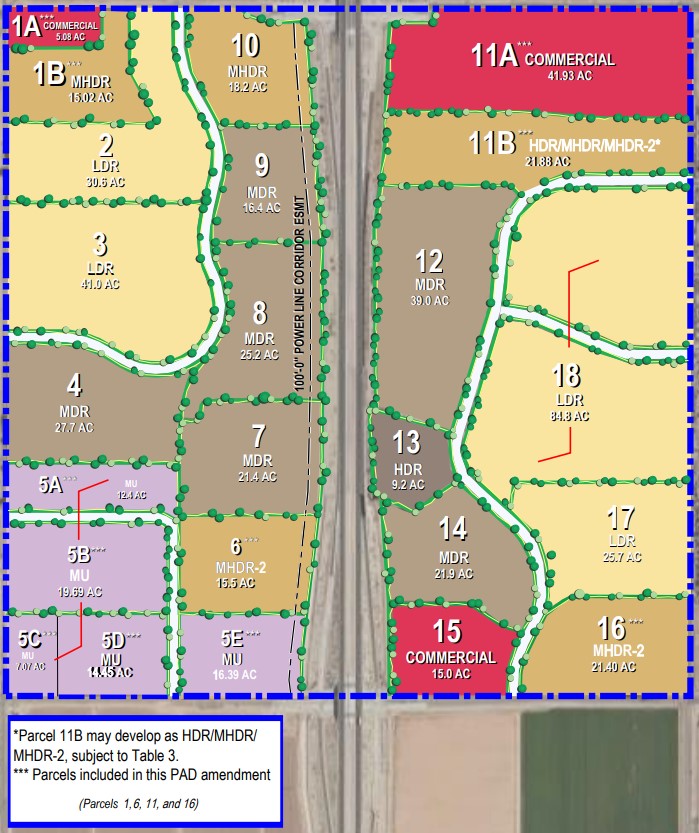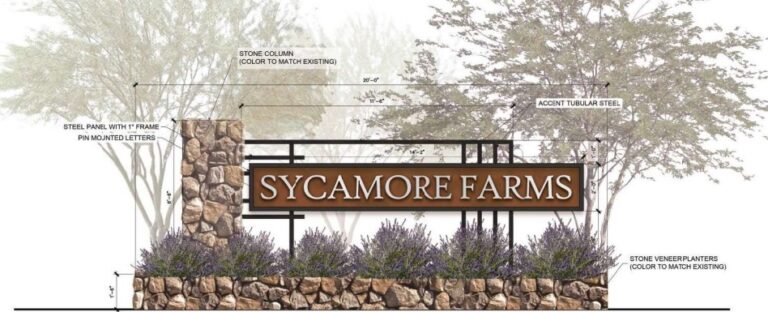By Roland Murphy for AZBEX
The scope of a Planned Area Development request in Surprise, coupled with a degree of neighborhood opposition, is raising complications for yet another long-term development project and adding to Surprise’s growing reputation as a municipality where it is difficult to get responsible growth planning done.
A proposed major Planned Area Development amendment in Surprise could change 73.8 acres of commercial/institutional area in the Sycamore Farms PAD to multifamily residential. The revision would change the land use plan, development standards and dwelling unit counts for a one-square-mile area bounded by Cactus Road, Sarival Avenue, Peoria Avenue and Cotton Lane, with the Loop 303 freeway running north-south through the middle of the site.
The request would change four parcels on the site and allow up to 946 new housing units, including the addition of Build-to-Rent as a newly permitted housing type. According to the staff report prepared for the Surprise Planning and Zoning Commission, “This results in a total allowed dwelling unit count of 3,801 across the entirety of Sycamore Farms, which encompasses 637.6 acres, and a density of 5.96 du/ac.”
The request also includes an amendment that would allow for by-right inclusion of a home improvement center “with or without outdoor ancillary uses.” The current PAD allows such use with a Conditional Use Permit but is limited to indoor uses only.
In addition to specific considerations set aside for the Loop 303 freeway, there are a total of 18 parcels in the Sycamore Farms PAD, which includes commercial, mixed-use, and low- medium-, medium-high- and high-density residential.
The current proposal could change the land use plan for four parcels.

“In total, the proposed amendment would result in 73.8 acres of commercial/institutional land being redesignated as multi-family residential,” according to the staff analysis.

Along with those land use changes, the analysis says, “The subject amendment proposes to include an additional designation of MHDR-2 to specifically accommodate the single family for rent or build-to-rent development type. Parcels 11B, 16, and 6 are proposed to hold this designation, and the mixed-use Parcel 5 will also allow for this development type. Associated development standards have been created for MHDR-2 and are consistent with the other multi-family residential development standards within the PAD.”
The new multifamily parcels in the PAD would be set with the following unit maximums:
- Parcel 1B: 288 units;
- Parcel 6: 128 units;
- Parcel 11B: 400 units, and
- Parcel 16: 130 units.
Development of the various parcels under the plan would be performed in various phases with different developers and timelines directed by perceived market needs and timing.
Resident Encounters and NIMBYism
Between the request’s original submittal and the time it came before P&Z, there was one required virtual, one required in-person and one optional in-person meeting held with surrounding residents. Additional door-to-door outreach efforts were also held.
During the various meetings, residents brought forward what has become a standard set of opposition points around the Valley—first and foremost being a desire for commercial instead of multifamily.
Supporting that opposition is the set of disproven beliefs that multifamily breeds crime, lowers property values, overburdens infrastructure and adds more traffic than commercial or office, all of which are demonstrably false.
Several residents spoke at the April 6 P&Z meeting, and these points were presented once again. Jason Morris of Withey Morris Baugh and other applicant representatives addressed these concerns both in the resident meetings and before the Commission.
As Scottsdale City Councilmember Tammy Caputi said in a recent housing symposium, however, “There is no amount of facts that can change (these people’s) minds.”
The History and Outcome of the Request
Since this set of revisions is far more extensive and detailed than most of the PAD amendments making their way through the approval process, AZBEX contacted Morris for clarification on the application following the April 6 Planning and Zoning Commission hearing. He explained it arose because multiple parties were looking at multiple, smaller changes in the PAD, and P&Z and planning staff recommended they all work together to deliver an omnibus change application.
“We all came to the City of Surprise independently on different parcels within Sycamore Farms,” Morris explained to the Commission during the applicants’ presentation in the meeting. “It didn’t make sense for six different applications to occur all at the same time within one master plan… with different applications and different uses. It was suggested we all get together and make this a joint application so that the Planning Commission and staff could consider the totality of the changes within all of Sycamore Farms even though there are fractured owners and different owners, different applicants for this application.”
He further explained the resulting application was, effectively, six cases, despite being one agenda item. He also praised the quality of the staff analysis and review in preparing the explanation of the overall proposal in terms Commission members could easily understand.
In watching the Members’ response to the applicants’ presentation, and despite the detailed application and simplified staff analysis, both speakers against the project and Commissioners, themselves, seemed perplexed by the individual items and their economic justifications.
After extensive discussion between Members—with some leaning in favor of the entire application, some leaning toward rejection, and some leaning to send the omnibus application back to the applicants to be redivided back into its separate pieces—the Commission ultimately voted on yet another option.
The final motion sought to recommend Council approve the requested changes for Parcel 11 but leave the uses for Parcels 1, 6 and 16 as they are currently stated.
Surprise City Council is scheduled to take up the original application and the Commission’s recommendation at its May 2 meeting. It is expected there will be a variety of negotiations between staff and applicant representatives in the interim, which will likely result in additional changes.

